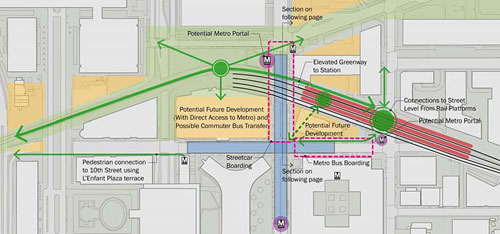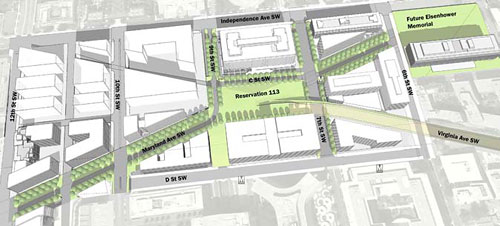Plan envisions decking railroad, adding 4th track in SW DC

L’Enfant Promenade, above the rail tracks.
One day, disjointed streets and lifeless blocks around L’Enfant Plaza could become a complete neighborhood with a connected street grid, park space, mixed-use buildings, and an expanded 4-track rail hub connecting MARC and VRE commuter trains to Metro, buses, and the DC Streetcar.
That’s the vision of DC’s Maryland Avenue SW plan. While there’s currently no funding to actually build the improvements it calls for, the plan can and should shape smaller steps to transform the area, including CSX’s National Gateway project to double-stack its trains.
For the this to be a reality, though, DC will need to start at least preliminary engineering soon. CSX is moving ahead with National Gateway planning, and if the the District wants to make sure that CSX’s work integrates rather than conflicts with the plan’s long-term vision for the area, more planning needs to be in place.
More tracks would serve a new L’Enfant station
The Maryland Avenue SW plan recommends building a new and larger L’Enfant rail station where the current station is today, and extends it farther east. Currently the rail line has 3 tracks through the area, and Amtrak, CSX, and the commuter railroads all want to expand it to 4. The expansion would let more commuter trains stop at L’Enfant, while allowing the Amtrak and freight trains to pass through without delay.
A 4th track would help MARC to run trains past Union Station to L’Enfant Plaza, letting MARC riders directly connect to the 4 Metro lines that don’t serve Union Station and thus get to jobs in the area more easily.
Right now, one of the other challenges to through-running MARC trains to L’Enfant is that MARC trains use high platforms at the level of the train floor, while VRE uses low platforms with stairs to the trains. The Maryland Ave plan recommends building platforms on both sides of some of the tracks in the new station, so that both high-floor and low-floor trains could use the same tracks and just open their doors on the side that accommodates their train height. These new platforms would also be longer than those in the current station.
That’s not the only logistical question to work out. The MARC Penn line uses electric wires for power. CSX has expressed concerns that their double-stack trains might not be able to reliably coexist with wires. They haven’t opposed putting wires on a new 4th track, but are reluctant to allow them on a second track, reducing the number of wire-free tracks to 2. Officials will have to work this out and hopefully convince CSX that the wires won’t interfere with their operation.
Streets would connect in a grid
The other major set of recommendations in the plan reintroduces a grid of streets, as once existed, but elevated above the railroad tracks.
The development known as the Portals, which includes the Mandarin Oriental hotel, decked over a short piece of the tracks to create a new Maryland Avenue west of 12th Street, which now ends in a circle. The plan suggests adding 3 more decked blocks here, from 12th west to 9th.
Immediately east of 12th Street is the “12th Street Expressway”, which branches off from the Southwest Freeway. There are off-ramps to D Street in each direction. The expressway then dives below the Mall to 12th Street NW. The plan recommends making this into a regular street, called 11th Street. It would have a regular intersection with the new Maryland Avenue where the off-ramps are today.
When the Department of Energy’s Forrestal complex is redeveloped according to the SW Ecodistrict plan, Virginia Avenue and C Street could also be restored through the site. The new 11th Street would continue through to Independence Avenue. The ramp to the tunnel under the Mall would be rebuilt to split off from 11th Street just north of the Maryland Avenue intersection, then go under C and the Mall.
We need to plan the track expansion now
The report estimates it would cost $429 million to build all of this. That money is not even close to available now, but there is something important that DC needs to do: the preliminary engineering for the station, tracks and deck. A more detailed architectural and engineering design will figure out exactly where the new platforms and station could fit.
That’s important because CSX is going to be spending a lot of money on these tracks to fit the double-stack trains it wants to run along its major east coast route, which passes right through DC. It’s going to lower the tracks here to fit those freight cars under some of the bridges. The plan notes that recreating Maryland Avenue will require lowering some of those bridges even further, which means lowering the tracks more.
And do some of the tracks need to shift a few feet here and there for the future L’Enfant rail station? When CSX lowers and rebuilds the tracks, that’s the time to put them in the right spot. CSX certainly wouldn’t pay to move the tracks later, and might not even allow DC to do it; once the line is running, they’ll want to keep it in use for freight trains.
CSX’s project will happen in the next few years. DC should fund enough engineering right now so it can push CSX to locate the tracks properly and design them to accommodate any neded infrastructure like electric wires. Then, whenever money comes up to create a new commuter rail station or deck Maryland Avenue, there’s no need to touch the tracks or disrupt freight trains again.
Perhaps one day, some people will move to homes at L’Enfant Plaza station and enjoy walking around a lively mixed-use neighborhood on top of the tracks, and be amazed when people tell them that once upon a time the neighborhood had no residents, no walkable Maryland Avenue in that area, restaurants almost all in underground malls, and a generally inhospitable feel. If people can’t tell that the neighborhood once felt like it does, that’ll be the best success of all.





